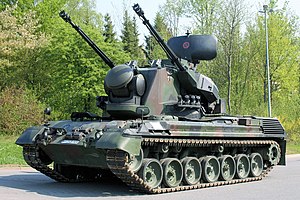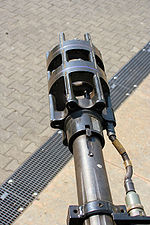Flakpanzer Gepard
This article needs additional citations for verification. (January 2013) |
| Flugabwehrkanonenpanzer Gepard | |
|---|---|
 Gepard 1A2 of the German Army | |
| Type | Self-propelled anti-aircraft gun |
| Place of origin | West Germany |
| Specifications | |
| Mass | 47.5 t (46.7 long tons; 52.4 short tons) |
| Length | Overall: 7.68 m (25 ft 2 in) |
| Width | 3.71 m (12 ft 2 in) |
| Height | Radar retracted: 3.29 m (10 ft 10 in) |
| Crew | 3 (driver, gunner, commander) |
| Armor | conventional steel |
Main armament | 2 × 35 mm autocannon, each with 320 rounds anti-air ammunition and 20 rounds anti-tank |
Secondary armament | 2 × quad 76mm smoke grenade dischargers |
| Engine | 10-cylinder, 37,400 cc (2,280 cu in) MTU multi-fuel engine 830 PS (819 hp, 610 kW) |
| Power/weight | 17.5 PS/t |
| Suspension | Torsion bar suspension |
Operational range | 550 km (340 mi) |
| Maximum speed | 65 km/h (40 mph) |
The Flugabwehrkanonenpanzer Gepard ("anti-aircraft cannon tank Cheetah", better known as the Flakpanzer Gepard) is an autonomous, all-weather-capable German self-propelled anti-aircraft gun (SPAAG). It was developed in the 1960s and fielded in the 1970s, and has been upgraded several times with the latest electronics. It constituted a cornerstone of the air defence of the German Army (Bundeswehr) and a number of other NATO countries. In Germany, the Gepard was phased out in late 2010 to be replaced by "SysFla", a mobile and stationary air defence system using the LFK NG missile and the new MANTIS gun system. The mobile platform of SysFla will likely be based on the GTK Boxer.[1]
Description

The vehicle is based on the hull of the Leopard 1 tank with a large fully rotating turret carrying the armament—a pair of 35 mm Oerlikon KDA autocannons and the two radar dishes—a general search radar at the rear of the turret and the tracking radar, and a laser rangefinder, at the front between the guns. Each gun has a firing rate of 550 rounds/min.
The guns are 90 calibres (3.15 m (10 ft 4 in)) long, with a muzzle velocity of 1,440 m/s (4,700 ft/s) (FAPDS—Frangible Armour Piercing Discarding Sabot rounds), giving an effective range of 5,500 m. The KDA autocannon can take two different ammunition types; the usual loading is a mix of 320 AA and 20 AP rounds per gun. Combined rate of fire is 1,100 rounds/min.
The electrically driven turret is powered by a 40 kW generator driven by a 4-cylinder, 3.8 litre Mercedes-Benz OM 314 multi-fuel engine.
Since the eighties, Stinger teams have been accompanying the Gepard units to take advantage of their long-range scanning capacity. To combine this capacity in a single unit, a missile system upgrade that mounts the NATO ManPad Stinger surface-to-air missile (in twin packs) to the autocannons was developed. The system was tested by the German Bundeswehr but not bought due to budget restrictions and the fielding of the Ozelot Light Flak (leFla) System.
The Gepard was developed from 1963 onwards. In 1969, construction began of four A prototypes testing both 30 and 35 mm guns. On 25 June 1970, it was decided to use the 35 mm type. In 1971, twelve second phase B prototypes were ordered; the same year the Dutch army ordered a CA preseries of five vehicles based on a parallel development that had used a German 0-series Leopard 1 vehicle made available by the German government in March 1970 as the C-prototype. The Germans made a small preseries of both the B1and B2R. On 5 February 1973, the political decision was made to produce the type; in September 1973 the contract was signed with Krauss-Maffei for 432 B2 turrets and 420 hulls with a total value of DM1,200,000,000. Each vehicle would thus be about three times the price of a normal Leopard 1. The first was delivered in December 1976. Belgium ordered 55 vehicles, which were identical to the German version. The Dutch ordered 95 vehicles, split into three batches (CA1, CA2 and CA3), which were equipped with Philips radar systems.
Technology and systems
Chassis and propulsion
The Gepard is based on a slightly modified chassis of the Leopard 1 main battle tank, including the complete drive unit with a 37.4-liter 10-cylinder multi-fuel engine (type: MB 838 CaM 500) with two mechanical superchargers built by MTU. The V-engine with a cylinder angle of 90 degrees has 610 kW at 2200 RPM (830 PS) and consumes, depending on the surface and driving style, around 150 liters per 100 kilometers. To ensure a steady supply of oil, even in difficult terrain and under extreme skew, the engine is provided with a dry sump forced lubrication. Even the gearbox (type: 4 HP-250) from ZF Friedrichshafen and the exhaust system with fresh air admixture to reduce the infrared signature were taken from the Leopard 1 MBT.
The Gepard is also equipped with a Daimler-Benz (type: OM 314) 4-cylinder diesel auxiliary engine for the energy supply system. This engine is on the front left of the vehicle, located where the Leopard 1 has an ammunition magazine. The engine, which has a 3.8 liter capacity, is designed as a multi-fuel engine and produces 66 kW (90 PS). It consumes, depending on the operational status of the tank, between 10 and 20 liters per hour (l/h). The auxiliary engine is coupled with five generators to operate at different speeds: Two Metadyn machines in tandem with a flywheel (which is used to store energy during the acceleration and deceleration of the turret) for the power of the elevation and traverse drives, two 380-Hz three-phase generators with a capacity of 20 kVA for the ventilation, fire control and radar systems, and a 300-A 28-volt direct current generator for the electrical system. The fuel capacity is 985 liters, which ensures a combined operating time of approximately 48 hours.
The chassis and the track were taken directly from the Leopard 1. It has torsion bar spring mounted roadwheels with seven roadwheel pairs per side. They are connected to the torsion bars on swing arms, whose deflection is limited by volute springs. Drive is through the drive sprockets located at the rear. The Rubber-mounted shocks were modified to achieve better stability during firing. The track is manufactured by the company Diehl, rubber track pads fitted, and is "live" track with rubber bushings between the track links and pins (type: D 640 A). Grouser/icecleats can replace the rubber pads on some track links to increase traction on slippery surfaces.
The hull only had slight modifications, i.e. a modified roadwheel distance (8 cm increased distance between the third and fourth roadwheel) and the transfer of additional batteries in battery boxes at the rear. The batteries and the electrical system operate at 24 volts DC.
Variants

There are two variants of Gepard in service; the Dutch has a different radar installation.
- Search radar: S band, 15 km range
- Tracking radar: Ku band, 15 km range
- Laser rangefinder
The Dutch version was officially called the PRTL (PantserRupsTegenLuchtdoelen translating to "ArmourTrackAgainstAirtargets"), pronounced as "pruttel" (meaning 'to sputter') by the soldiers. The Dutch series version was made public through a photograph of a vehicle from a C-Company, the first to be equipped with the new weapon. Traditionally all Dutch vehicles in a company have names beginning with the company designation letter and this vehicle happened to have the individual name Cheetah painted in bold type on its turret. Inevitably the international press assumed "Cheetah" was the Dutch name for their Gepard version and this mistake found its way into most armour publications on the subject. In 2000 the Dutch military authorities, tired of constantly having to explain all this and considering "pruttle" was hardly a martial name anyway, conformed themselves to common error and made "Cheetah" the official designation, when the system was upgraded.[citation needed]
Operators

Current operators
 Brazil: 36 ordered from the Bundeswehr.[2]
Brazil: 36 ordered from the Bundeswehr.[2] Germany: 377 originally built for the Bundeswehr, 94 remained in service until 2010 and are currently stored until SysFla is fully introduced.
Germany: 377 originally built for the Bundeswehr, 94 remained in service until 2010 and are currently stored until SysFla is fully introduced. Jordan: 60 have been receives from withdrawn Dutch surplus for 21 million dollars.[3]
Jordan: 60 have been receives from withdrawn Dutch surplus for 21 million dollars.[3] Romania: 43 delivered (36 + 7 for spares), all ex-Bundeswehr stocks.[4]
Romania: 43 delivered (36 + 7 for spares), all ex-Bundeswehr stocks.[4]
Former operators
 Belgium: 55 delivered, withdrawn from service.
Belgium: 55 delivered, withdrawn from service. Chile: Former user. Four vehicles delivered in 2008, and returned in January 2011. Equipment originally operated by the Bundeswehr. Order of 30 vehicles cancelled due to high overhaul/upgrade costs.[5]
Chile: Former user. Four vehicles delivered in 2008, and returned in January 2011. Equipment originally operated by the Bundeswehr. Order of 30 vehicles cancelled due to high overhaul/upgrade costs.[5] Netherlands: 95 delivered, withdrawn from service.
Netherlands: 95 delivered, withdrawn from service.
Comparable systems
- K30 Biho
- M247 Sergeant York
- Marksman anti-aircraft system
- PZA Loara
- Tunguska-M1
- Type 95 SPAAA
- Type 87 self-propelled anti-aircraft gun
- ZSU-23-4 Shilka
Notes
- ^ "The "Cheetah" has served its purpose" (in German). KN-Online. 9 March 2010. Retrieved 16 April 2010.
- ^ "Brazilian Army will acquire 36 Gepard anti-aircraft guns", Army recognition, December 10, 2012.
- ^ "Jordan buys surplus tanks" (in Dutch). Nederlandse Omroep Stichting. Retrieved 14 February 2012.
- ^ "Self-propelled antiaircraft complex "Cheetah"" (in Romanian). Romanian Ministry of Defence. Retrieved 16 April 2010.
- ^ "Chile devolve os Gepard", Segurança e defesa (in Portuguese).
External links
- Gepard Photos and Walk Arounds on Prime Portal
- Gepard at Army Technology
- Gepard at GlobalSecurity.org
- Gepard at Defence Journal


